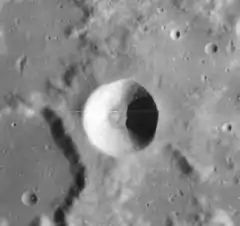Maury (crater)
Maury is a small lunar impact crater named for two cousins. It was first named in honor of Lieutenant Matthew Fontaine Maury of the U. S. Naval Observatory and later shared to honor Antonia Maury of Harvard College Observatory. The crater lies in the northeastern part of the Moon, just to the east of the Lacus Somniorum. The nearest named craters are Hall to the southwest, and Cepheus farther to the northeast. Just to the west of Maury is the lava-flooded remains of the satellite crater Maury C.
 Lunar Orbiter 4 image | |
| Coordinates | 37.1°N 39.6°E |
|---|---|
| Diameter | 18 km |
| Depth | 3.3 km |
| Colongitude | 321° at sunrise |
| Eponym | Matthew Fontaine Maury Antonia Maury |
This is a young bowl-shaped crater with a circular rim and a tiny flat floor at the midpoint. The surface of the floor has a cluster of small hills. The inner walls appear lighter than the surrounding terrain due to higher albedo. This is normal for recently formed craters, and the interior will gradually grow darker due to space weathering.
Satellite craters
By convention these features are identified on lunar maps by placing the letter on the side of the crater midpoint that is closest to Maury.
| Maury | Latitude | Longitude | Diameter |
|---|---|---|---|
| A | 36.0° N | 41.8° E | 21 km |
| B | 35.1° N | 42.0° E | 9 km |
| C | 37.0° N | 38.6° E | 28 km |
| D | 38.2° N | 37.8° E | 8 km |
| J | 39.1° N | 40.1° E | 6 km |
| K | 39.5° N | 41.1° E | 5 km |
| L | 40.3° N | 42.5° E | 4 km |
| M | 40.8° N | 42.6° E | 16 km |
| N | 40.4° N | 41.9° E | 17 km |
| P | 39.9° N | 38.0° E | 12 km |
| T | 40.0° N | 43.3° E | 3 km |
| U | 39.3° N | 37.0° E | 5 km |
References
- Wood, Chuck (August 22, 2007). "Little Peaks". Lunar Photo of the Day. Archived from the original on September 27, 2007. Retrieved 2007-08-22.
- Andersson, L. E.; Whitaker, E. A. (1982). NASA Catalogue of Lunar Nomenclature. NASA RP-1097.CS1 maint: ref=harv (link)
- Blue, Jennifer (July 25, 2007). "Gazetteer of Planetary Nomenclature". USGS. Retrieved 2007-08-05.CS1 maint: ref=harv (link)
- Bussey, B.; Spudis, P. (2004). The Clementine Atlas of the Moon. New York: Cambridge University Press. ISBN 978-0-521-81528-4.CS1 maint: ref=harv (link)
- Cocks, Elijah E.; Cocks, Josiah C. (1995). Who's Who on the Moon: A Biographical Dictionary of Lunar Nomenclature. Tudor Publishers. ISBN 978-0-936389-27-1.CS1 maint: ref=harv (link)
- McDowell, Jonathan (July 15, 2007). "Lunar Nomenclature". Jonathan's Space Report. Retrieved 2007-10-24.CS1 maint: ref=harv (link)
- Menzel, D. H.; Minnaert, M.; Levin, B.; Dollfus, A.; Bell, B. (1971). "Report on Lunar Nomenclature by the Working Group of Commission 17 of the IAU". Space Science Reviews. 12 (2): 136–186. Bibcode:1971SSRv...12..136M. doi:10.1007/BF00171763.CS1 maint: ref=harv (link)
- Moore, Patrick (2001). On the Moon. Sterling Publishing Co. ISBN 978-0-304-35469-6.CS1 maint: ref=harv (link)
- Price, Fred W. (1988). The Moon Observer's Handbook. Cambridge University Press. ISBN 978-0-521-33500-3.CS1 maint: ref=harv (link)
- Rükl, Antonín (1990). Atlas of the Moon. Kalmbach Books. ISBN 978-0-913135-17-4.CS1 maint: ref=harv (link)
- Webb, Rev. T. W. (1962). Celestial Objects for Common Telescopes (6th revised ed.). Dover. ISBN 978-0-486-20917-3.CS1 maint: ref=harv (link)
- Whitaker, Ewen A. (1999). Mapping and Naming the Moon. Cambridge University Press. ISBN 978-0-521-62248-6.CS1 maint: ref=harv (link)
- Wlasuk, Peter T. (2000). Observing the Moon. Springer. ISBN 978-1-85233-193-1.CS1 maint: ref=harv (link)